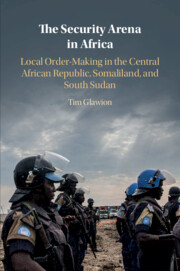 The Security Arena in Africa
The Security Arena in Africa Published online by Cambridge University Press: 16 January 2020
Chapter 3 draws on the historical basis laid out in the prior chapter to establish how the current national security arenas of each country came about and what it means for the local cases under scrutiny here. Going beyond the national level, decisions made by peacekeeping headquarters and mission contributors inform the actions of international actors and form a sort of international security arena. The described historical legacies, narratives, and capacities of actors on the national and international levels shape the corridor in which different ordering practices can be negotiated at the local level.
To save this book to your Kindle, first ensure no-reply@cambridge.org is added to your Approved Personal Document E-mail List under your Personal Document Settings on the Manage Your Content and Devices page of your Amazon account. Then enter the ‘name’ part of your Kindle email address below. Find out more about saving to your Kindle.
Note you can select to save to either the @free.kindle.com or @kindle.com variations. ‘@free.kindle.com’ emails are free but can only be saved to your device when it is connected to wi-fi. ‘@kindle.com’ emails can be delivered even when you are not connected to wi-fi, but note that service fees apply.
Find out more about the Kindle Personal Document Service.
To save content items to your account, please confirm that you agree to abide by our usage policies. If this is the first time you use this feature, you will be asked to authorise Cambridge Core to connect with your account. Find out more about saving content to Dropbox.
To save content items to your account, please confirm that you agree to abide by our usage policies. If this is the first time you use this feature, you will be asked to authorise Cambridge Core to connect with your account. Find out more about saving content to Google Drive.